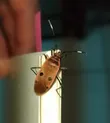Harmful Effects of Physopelta cincticollis
A species of Physopelta
Physopelta cincticollis poses risks to agriculture by sucking plant fluids, causing leaf wilting and fruit deformation. While low populations result in minor damage, high densities can severely reduce crop yields, affecting agricultural economies. The severity of the impact is amplified by human reliance on the crops affected.
What Type of Pest Is Physopelta cincticollis?








AI entomologist in your pocket
Scan QR code to download

